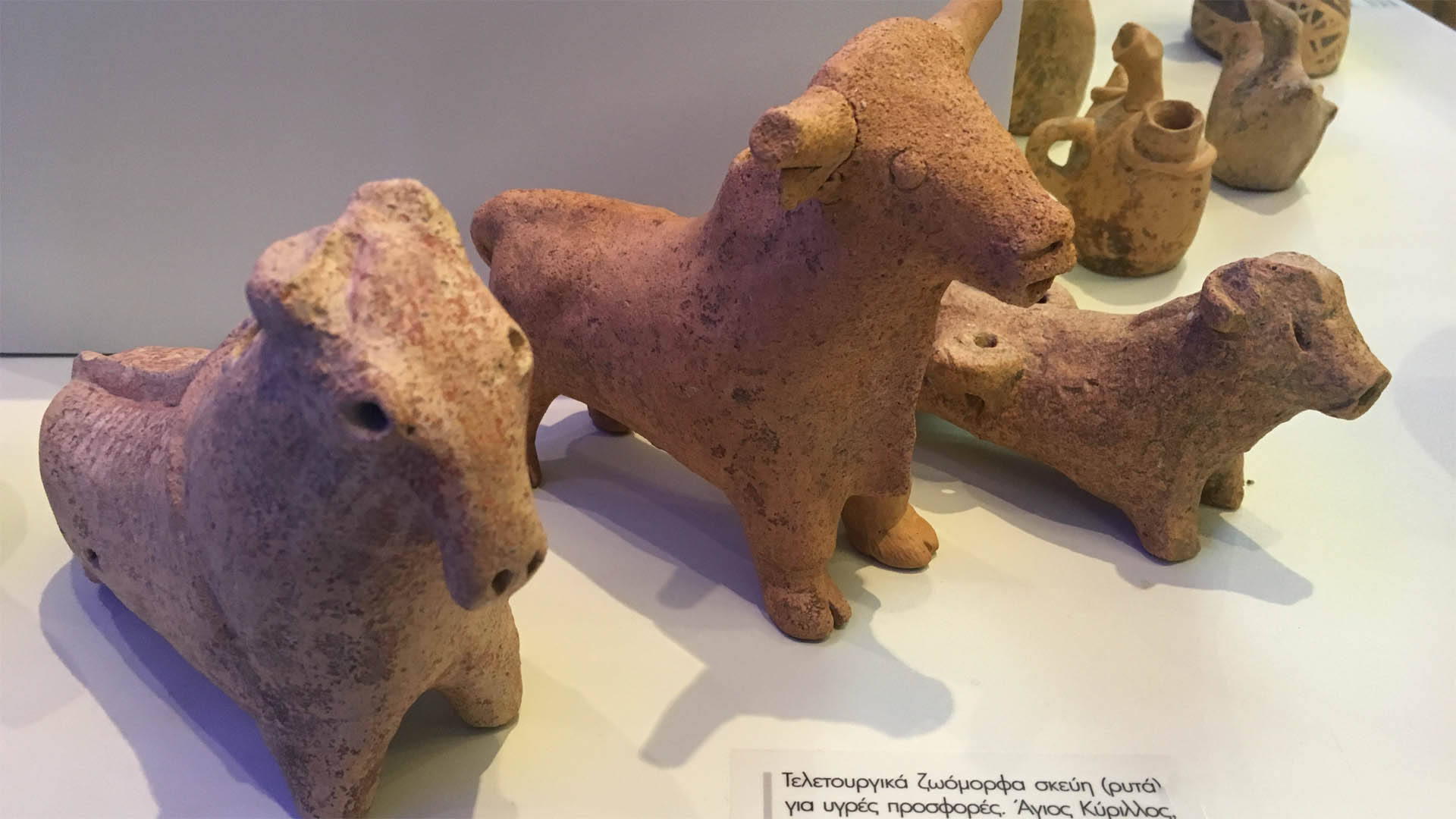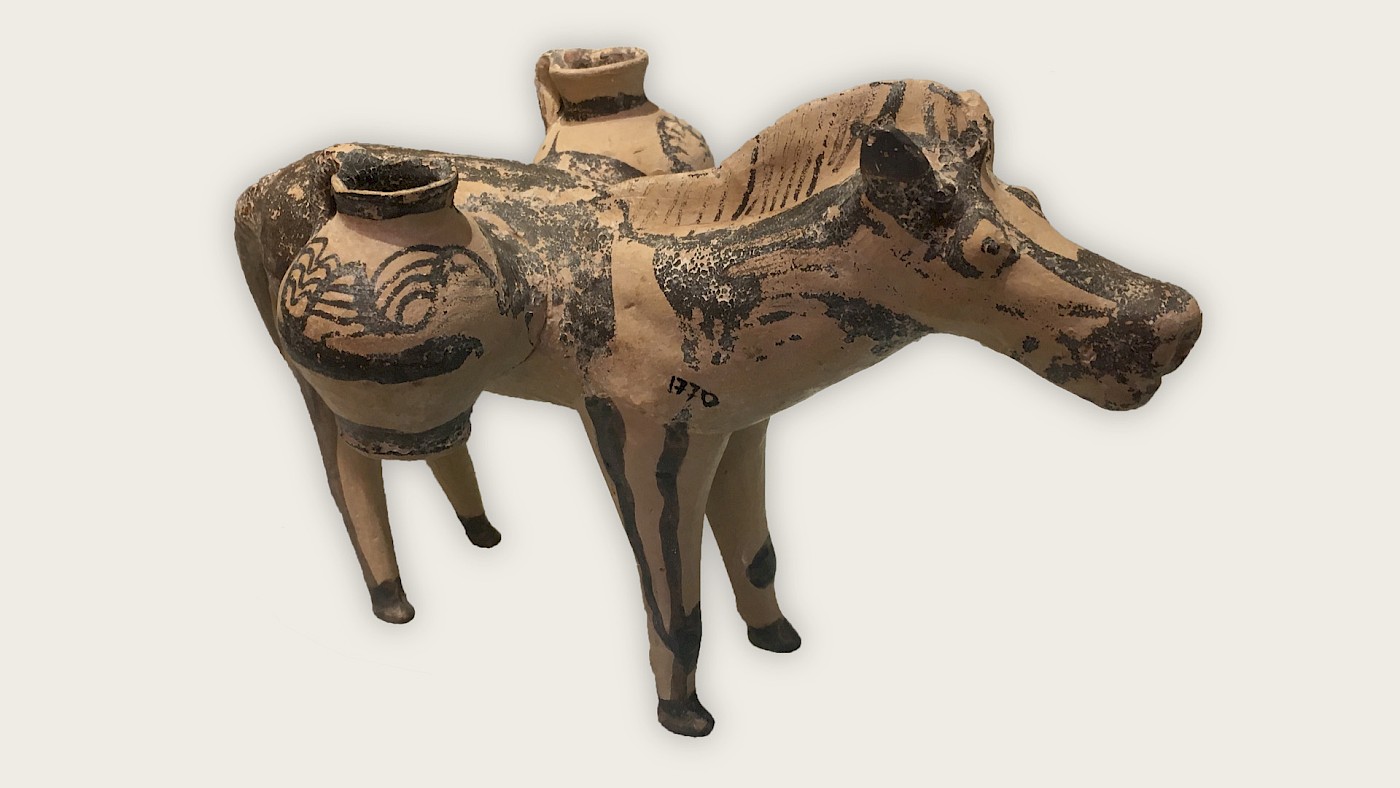A terracotta vessel made in the shape of an equid is one of the most charming objects in the Archaeological Museum of Iraklion. The descriptive plaque refers to it as a “beast of burden” and dates it to between 1100 and 900 BC – a very wide range. This terracotta equid was unearthed by the Italian mission in the area of the palace at Phaistos, in the northwest corner of the Central Court, at the beginning of the twentieth century.
Things become strange when you look for this object online and find that it’s often referred to specifically as a donkey (or ass), with a much earlier date: between 1350 and 1200 BC. However, it turns out that the description of this object as a donkey, as well as the earlier date, is based on the descriptive plaque that accompanied the object before the museum was renovated. But what type of animal is represented here, and which of these dates is correct?
To find the answer, I consulted Joost Crouwel’s book Chariots and Other Means of Transport in Bronze Age Greece (1981), thinking that it would almost certainly be included there. And indeed, Crouwel lists this terracotta object – a rhyton, i.e. a vessel for drinking/pouring liquids – in his catalogue as number T53 (p. 162). The book also has a drawing of it (plate 50), showing the part that was actually unearthed: the body along with the neck and head.
The legs and most of the tail in the photo, above, are modern reconstructions. You can make this out when you look at the object carefully, as the colour of the clay is slightly different, and you can even spot the seams. Incidentally, you can also clearly read the museum’s inventory number: 1770.
Funnily enough, Crouwel doesn’t date the object to either 1350-1200 BC or 1100-900 BC, but to the period in between these two date ranges: Late Minoan IIIC, or, roughly, the twelfth century BC! So now we have three different sets of dates, none of which overlap. Which of these dates is correct? Indeed, are any of them correct?
Different dates
Fortunately, Crouwel’s catalogue entry contains a bibliography listing references to eight books and articles, including the original excavation report by Pernier, published in volume 12 of Monumenti Antici publicata per cura della academia nazionale dei Lincei in 1902.
I was lucky that Josh Hall knew exactly where to locate this report online. On the relevant page (column 118) in Pernier’s work, there is a brief description of the object and a picture where the legs have been restored but are still unpainted. A few decades later, Arthur Evans discusses the object, which he calls “of very late Minoan date”, in the first part of the second volume of his monumental The Palace of Minos (1928).
In a footnote (n. 2) on p. 157, Evans summarizes some of the relevant literature and writes:
L. Pernier, Mon.Ant., xii, p. 118, Fig. 47. It is described there as a “horse”; by D. Fimmen (Die kretisch-mykenische Kultur, 2nd ed., p. 114) as a “horse or mule”, but the small size of the animal and stiff mane are more characteristic of an ass. The ears of early forms of asses (such as the Tibetan wild ass, for instance) are by no means so prominent as those of the donkeys with which we are familiar. The legs and tail of the figure were broken off. The object itself is a kind of toy vessel – liquid poured into the pots coming out at the animal’s nostrils, as in the case of some Minoan “rhytons”.
Evans says that the jars, which he identifies as “large water pots”, feature a type of “decorative design” that suggests a date in late Late Minoan IIIB, or towards 1200 BC to put it in absolute terms. This argument is based on style rather than stratigraphy.
For further information we can turn to Athanasia Kanta’s The Late Minoan Period in Crete. A Survey of Sites, Pottery and Their Distribution (1980), which is, as luck would have it, available in full on her Academia profile.
Kanta unequivocally writes that the object was found in a Late Minoan IIIC context, alongside other figurines and vases (p. 96). The “horse”, as she calls it – following Pernier – has parallels from Ialysos on Rhodes and Cyprus. She concludes that the “figurines confirm the existence of a cult area” (p. 97). It is most definitely not a “toy”, as Evans suggested.

Of course, these references are all quite old: maybe something changed over the course of the next few decades? I consulted Robert Koehl’s massive Aegean Bronze Age Rhyta (2006). In the discursive text, he dates the equid to Late Minoan IIIB (p. 11), siding with Evans. But in his catalogue (item no. 43), he gives the date as either Late Minoan IIIB or Late Minoan IIIC (p. 79). Interestingly, he notes the following about this particular type of vessel (p. 12):
However, the Type I Figural: zoomorphic seems to die out on Crete after LM IB, recurring only with 43 in the LM IIIB period. Perhaps the occurrence of this rhyton in a unique cultic context explains its appearance. It may have been an effort to revive a once familiar, yet special, kind of vessel for specific use in this context […].
Rhyta shaped like animals were apparently a characteristic feature of the period before Late Minoan IB, which is the final phase of the Neopalatial era (i.e. before ca. 1450 BC). There are apparently no known examples for the Late Minoan II and IIIA periods, i.e. the remainder of the fifteenth and most of the fourteenth centuries BC.
The date originally suggested by the museum, ca. 1350-1200 BC, corresponds more or less to Late Minoan IIIB, i.e. between ca. 1330/15 and 1200/1190 BC, as per Sturt Manning’s discussion in Eric Cline’s Oxford Handbook to the Aegean Bronze Age (2010), especially his table 2.2.

All of this information suggests that the object most likely dates to either “very late Late Minoan IIIB” (as Evans put it) or (early?) Late Minoan IIIC (as per Kanta’s discussion based on the excavation reports). At this point, it’s good to remember that objects may well be older than the contexts in which they are found. Still, we’re probably not too far off the mark if we date this object, in absolute terms, to ca. 1200/1190 BC, the point where IIIB transitions into IIIC.
The plot thickens
Dating the object to around 1200 BC seems to make sense. However, we are left with one important question: where does the 1100-900 BC date come from that the museum now gives for this terracotta equid?
I reached out to the Archaeological Museum of Iraklion. Mrs Eirini Galli was kind enough to respond, writing that the object “was considered by the archaeologists working at the time of the implementation of the re-exhibition, as stylistically closer to the Protogeometric figurines tradition than to the LM IIIB or LM IIIC” (e-mail dated 5 November 2020).
At first blush, the problem with this date is that it’s apparently based on stylistical analysis, rather than taking the context into account. The context in which the object has been found appears to be rather securely dated to the Late Minoan IIIC period. The object may well have been made during an earlier period, such as Late Minoan IIIB, as favoured by Evans, and then buried with the other objects related to ancient cult.
But could the item be younger than the context in which it was found? It’s possible, but not probable – certainly, modern excavation methods would usually detect the processes involved. One possibility is that the object was buried – perhaps indeed during the Protogeometric period suggested by the museum – in a pit that was dug into the Late Minoan IIIC layer. Another possibility is that the object was moved from its original location in the ground due to the activities of burrowing animals or the roots of plants. The stratigraphical evidence that would prove either of these possibilities may have gone unnoticed by the excavators at the time.

The point that the equid represents figurines from the Protogeometric period is a good one, since indeed zoomorphic objects are a feature of the Early Iron Age, even if this object is a rhyton rather than a figurine. Evans dated the object to Late Minoan IIIB, based on the style of the decorative design on the water jars. But I can easily see how the decoration on these pots could also be interpreted as resembling Protogeometric vessels.
Koehl was apparently puzzled by the object, believing it to be a revival of an earlier tradition of zoomorphic vessels that ended in Late Minoan IB, at least one hundred years – if not more – than its earliest suggested date (Late Minoan IIIB). But if we follow the argument of the museum and date it to between 1100-900 BC, the object fits the then-contemporary tradition of making objects in the shapes of animals.
Clearly, a firm answer with respect to the date of this object requires further research, drawing comparisons with similar objects from both the (Late) Bronze Age and the Early Iron Age. A re-examination of the excavation reports is also in order. Considering the age of the excavation, conducted a hundred years ago, it’s also possible we may never get a definitive answer.
Which animal is it?
Having dealt with the matter of the object’s date, we are still left with another question: what kind of animal is this object supposed to represent? It’s clear that the museum originally sided with Evans in identifying it as an “ass” (i.e. a donkey).
But someone in the museum changed the description relatively recently to identify it more generally as a “beast of burden”. Crouwel is noncommittal in calling it simply an equid, as I have done in this article. Since the tail is missing, it’s difficult to see if it’s supposed to be a donkey or a mule – or indeed a horse.
The argument that the stiff mane is “more characteristic” of a donkey is true, but doesn’t mean too much. It doesn’t take long to find examples of Aegean and later Greek depictions of animals that are clearly horses with an upright mane. Indeed, a few pictures – all admittedly dating to the first millennium BC rather than the second, though this is perhaps not a problem considering the museum’s redating of the object! – can be found in my 2007 BABesch article for which a download link can be found here.
A more compelling argument against identifying this animal as a horse is the fact that it’s used to transport two jars or amphorae. Horses were too precious in the Aegean to use for anything other than riding and as draught animals for chariots. So it seems most probable that the animal is either a donkey or a mule, rather than a horse.
Further reading
- Joost Crouwel, Chariots and Other Means of Transport in Bronze Age Greece (1981).
- Arthur Evans, The Palace of Minos: Vol. II, Part 1 (1928).
- Athanasia Kanta, The Late Minoan Period in Crete. A Survey of Sites, Pottery and Their Distribution (1980).
- Robert Koehl, Aegean Bronze Age Rhyta (2006).
- Luigi Pernier, “Scavi della missione italiana a Phaestos 1900-1901: rapporto preliminare”, Monumenti Antici publicata per cura della academia nazionale dei Lincei 12 (1902), cols 5-142.
